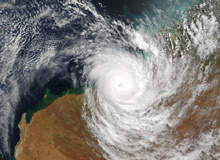
The Wheatstone project is located in the Carnarvon Basin, approximately 90 miles off the coast of Western Australia, at water depths of 650ft (200m).
The field was discovered in 2004 and is operated by Chevron. The project comes under WA-253-P and WA-17-R permit areas, which are owned by Chevron.
Design studies for the field’s development and production, site evaluation and field appraisal work were completed in 2008, as part of Chevron’s wider strategy. The company will process hydrocarbons from the gas fields in the two permit areas WA-253-P and WA-17-R.
The Wheatstone facility will be developed in two phases and is expected to have a capacity to produce up to 25Mtpa of LNG. It will supply 8.9Mtpa of LNG in the initial phase.
Construction on the project started in December 2011 with a $29bn investment and first production was achieved in October 2017. The first phase involved the construction of two LNG processing trains with a capacity of 4.45Mtpa each and a domestic gas plant.
Phase one is expected to recover approximately 4.5 trillion cubic feet of natural gas resources located within the two permits.
Wheatstone project location
In December 2008, Ashburton North on the Pilbara coast of Western Australia was selected as the location for the LNG facility and the gas plant, based on a study of environmental and social aspects. The site is 12km from Onslow on the Pilbara coast.
The site is near the Lago, Brunello and Julimar fields, which are the sources of raw materials to the facility.
Natural gas for the trains will be initially supplied by the Chevron-operated Wheatstone and Iago gas fields. The Lago, Brunello and Julimar fields will supply additional raw materials to the facility.
Offshore processing
Gas and condensate required to produce the initial 10Mtpa will come from the two permit areas and will be transferred onshore through a pipe for further processing.
The products will come through subsea wells and be transmitted via a network of subsea pipelines to the central processing platform to be located over the gas field.
The subsea system consists of gas flowlines, manifolds and injections lines and power umbilical lines. Segregation and cleaning of gas, condensate and water will be carried out at the platform, which is yet to be developed.
The products will be dehydrated, compressed and transferred to an onshore plant through a 200km subsea trunkline.
Gas and LNG facilities
In March 2008, Chevron proposed to construct a domestic gas plant, along with the LNG facility. The plant was built with a production capacity of 200 TJ/per day.
The domestic gas plant is independent of the Wheatstone project but forms part of the project development. The gas plant will supply domestic gas to the local market.
Wheatstone facility contracts
4.1Mtpa of LNG produced at the facility will be supplied to Tokyo Electric Power (TEPCO) until 2030 in accordance with an agreement signed in December 2009.
TEPCO may also take 15% of equity share in the project field licences and 11.25% interest in Wheatstone natural gas processing facilities to be developed onshore in northwestern Australia.
Apache Julimar and KUFPEC Australia (Julimar) have been chosen as natural gas suppliers for the Wheatstone facility. Under the agreement signed in October 2009, 25% of inlet gas to trains 1 and 2 of the project will be supplied from the Julimar and Brunello fields.
Chevron holds 73.6% in the Wheatstone project. A 26.4% equity share of the facilities is given to suppliers: Apache has 13% of the stake and KUFPEC holds 7%.
In April 2011, Chevron signed an agreement with Shell Development Australia to become an equity partner and natural gas supplier for the project.
Shell will hold a 6.4% interest in the facility and an 8% interest in the Wheatstone and Iago fields
Environmental approval
The environmental approval process for the Wheatstone project began in September 2008. The environmental scoping studies were submitted in February 2009 and the project received conditional environmental approval in June 2011.
Contractors involved
The contract to design the subsea gas gathering facilities and pipeline was awarded to Intecsea in December 2009. Technip Oceania was awarded the production platform design contract during the same time. The contract includes the 200km pipeline between the offshore facility and the LNG plant.
A subcontract to Jumbo was awarded by Technip Oceania to install 13 subsea structures in November 2014.
The FEED contract for phase one development was awarded to Bechtel Oil, Gas & Chemicals in August 2009.



